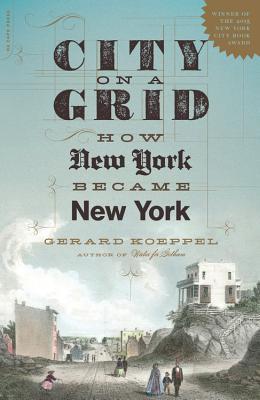
City on a Grid
How New York Became New York
کتاب های مرتبط
- اطلاعات
- نقد و بررسی
- دیدگاه کاربران
نقد و بررسی

September 14, 2015
Historian Koeppel (Bond of Union) continues his examinations of New York–centric infrastructure with a look at the story behind the development of New York City’s extraordinary 1811 street grid plan, which “defined the urbanism of a rising city and nation.” Devastated by the 9/11 attacks, Koeppel launched his expert investigation into what made the city special, using a photo from the early 1880s of early Manhattan that showed the grid—“a rectilinear plane of many parallel streets crossed at right angles”—in the midst of the newly developing Upper East Side neighborhood now known as Carnegie Hill. Koeppel is fascinated by the history of old New York; Manhattan’s grid, conceived by city planner Casimir Goerck and French designer Joseph François Mangin, came to make it both a “congested place” and an “orderly place of energy and industry.” Mangin’s plan met stout resistance from city commissioners and faced several challenges, but without any political alternative, it survived, sparking an influx of population and commerce. Koeppel’s bold commentary on the constant evolution of Gotham may stir controversy in some quarters, but he unabashedly celebrates the metropolis that has never learned what it means to grow old or stale. Maps and b&w photos.

August 15, 2015
A popular historian examines the origin and development of Manhattan's famous grid. Given exclusive power and broad discretion, charged with uniting "regularity and order with public convenience," the three-man state commission appointed in 1807 took four years to come up with the rectilinear grid-150 parallel streets, 12 parallel avenues, 2,000 almost identical blocks-that continues to order the daily life of Manhattan. Their design, likely cribbed from earlier maps and surveys, short on "beautifying embellishments," and long on simplicity and efficiency, accomplished (along with the roughly contemporaneous construction of the Erie Canal) precisely the goal of town fathers: to turn New York into the nation's leading city. Though he focuses on the commission and their design and the controversies and criticisms arising over the next 10 years as chief surveyor John Randel Jr. executed their vision, Koeppel (Bond of Union: Building the Erie Canal and the American Empire, 2009, etc.) also tells a pre-grid, streets-and-roads story of Colonial-era Manhattan, bringing readers up through to the political rivalry of Aaron Burr and Alexander Hamilton, whose battles helped set the stage for the commission's work. As he follows the relentless grid's progress, from the edges of the settled old city all the way uptown, delightful detours pop up: about the anomaly that is Broadway, about the creation of Central Park ("the grid's unimagined saving grace"), and about 20th-century proposals to fill in the East River or to add three levels to the too-few avenues to relieve congestion. Scattered throughout the narrative, well-chosen, lively comments from writers, poets, politicians, architects, and scholars either roast or toast the commission's creation. Koeppel delivers all this with great verve and humor, leaving readers to decide whether the grid is the brilliantly democratic, effective plan its architects thought or the dull and ugly manifestation of unimaginative minds ruled by commerce. For Manhattanites, surely, and for anyone who's visited and been either charmed or overwhelmed by the grid.
COPYRIGHT(2015) Kirkus Reviews, ALL RIGHTS RESERVED.




















![Design Like You Give a Damn [2]](https://dl.bookem.ir/thumbnails/150/ISBN13/9781613122860.jpg)




دیدگاه کاربران